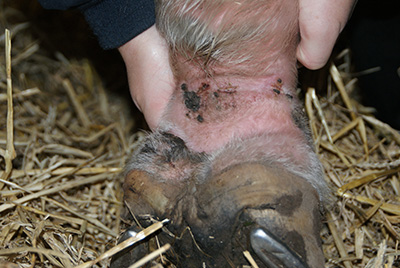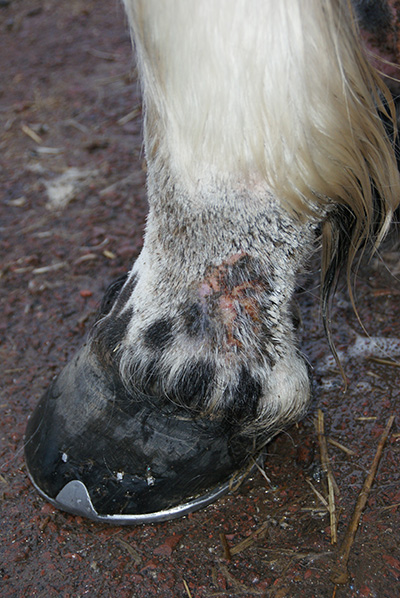Vet Advice: Mud Fever Management
 British weather means rainy days are a typical feature of winter and early spring, resulting in our horses and ponies spending more time standing in the mud when they are turned out. Mud fever is a common finding in these situations, so it is hardly surprising that a recent study by the Blue Cross Equine Charity found that mud fever accounted for 40% of skin disease in horses. Mud fever is a non-contagious (meaning it does not pass from horse to horse) skin condition that causes for irritation, pain, and scabs to form on the lower limbs of horses. In more severe cases, swelling and lameness of the affected limbs can occur. The most frequently affected areas are the back of the pastern, between the fetlock and the hoof. Understanding how to prevent and manage the condition can make a big difference.
British weather means rainy days are a typical feature of winter and early spring, resulting in our horses and ponies spending more time standing in the mud when they are turned out. Mud fever is a common finding in these situations, so it is hardly surprising that a recent study by the Blue Cross Equine Charity found that mud fever accounted for 40% of skin disease in horses. Mud fever is a non-contagious (meaning it does not pass from horse to horse) skin condition that causes for irritation, pain, and scabs to form on the lower limbs of horses. In more severe cases, swelling and lameness of the affected limbs can occur. The most frequently affected areas are the back of the pastern, between the fetlock and the hoof. Understanding how to prevent and manage the condition can make a big difference.
 Despite a horse’s skin being very tough and capable of brushing through birch for example, when it becomes waterlogged due to wet weather and mud, it becomes susceptible to damage and infection.
Despite a horse’s skin being very tough and capable of brushing through birch for example, when it becomes waterlogged due to wet weather and mud, it becomes susceptible to damage and infection.
Particles of sand or grit that are present in mud can cause for micro-abrasions to form on the surface of the skin. This allows bacteria present in the surrounding environment to enter and establish an infection.
Early signs of mud fever will be reddening of the affected skin and hard crusty scabs will begin to appear. Pink skin under white hair is most commonly affected but dark skin can also be affected.
Treatment
If you become concerned that your horse may have mud fever it is important to contact your vet as a correct diagnosis will allow the best treatment plan to be formulated. In mild cases the following general treatment is appropriate:
• Remove your horse from the muddy environment to prevent further damage occurring. Stabling your horse in a dry stable with an absorbent clean bed will help to dry the legs. It is best to avoid hosing the legs with cold water as this will cause for further irritation to the skin.
• Areas of affected skin should be cleaned twice a day using warm water and a dilute antiseptic such as chlorohexidine. Washing should be done gently to prevent further abrasions occurring on the skin surface. When using chlorohexidine, it is most effective when contact on the skin is maintained for seven minutes. In practice, this means it is best to gently wash the skin and then leave the horse tied up on a dry surface for a few minutes before washing the chlorohexidine off using clean water. After washing, the legs should be dried using a clean towel.
 • Loose scabs should be removed to allow the skin below to be washed and heal. With repeated washes, scabs will soften and become easier to remove. You should avoid removing scabs that are firmly attached as this will be very painful, unless advised by your vet.
• Loose scabs should be removed to allow the skin below to be washed and heal. With repeated washes, scabs will soften and become easier to remove. You should avoid removing scabs that are firmly attached as this will be very painful, unless advised by your vet.
• Clipping of hair or feathers from the affected area will be beneficial in allowing the skin to be washed and then dried.
If there is a poor response to initial treatment, or the mud fever gets worse, then you should contact your vet. In more severe cases a blood test may be required to investigate if there is an underlying cause. If the mud fever isn’t clearing up, a swab can also be taken to check for bacterial growth and sensitivity, allowing for the appropriate use of antibiotics.
Prevention
Avoiding skin irritation is the key to preventing bacteria entering the skin. The following steps can all help to reduce the risk of mud fever:
• Avoid horses standing in mud for prolonged periods of time. Stoning gateways and areas where horses are fed hay in the field can prevent this.
• Rotating paddocks will prevent fields becoming poached and avoiding the use of poorly drained areas of land for winter grazing will also help prevent mud fever.
• Avoid washing off your horse’s legs when you bring him in from the field and instead wait until the mud is dry, then brush it off using a soft bristled brush. If you do wash your horse’s legs, dry them thoroughly afterwards using a clean, dry towel. Mud fever is far more common in horses that have been managed by daily hosing of their legs.
• Regularly checking your horse’s legs will ensure mud fever is detected at an early stage.
Did you know?
It is important to remember that mud fever is most common in the winter and associated with persistent wet conditions. During the summer months, Pastern and cannon leukocytoclastic vasculitis are immune-mediated conditions which can look very similar to mud fever but require different treatment. They are usually seen in the summer and are thought to be allergic reactions to either sunlight or something in the environment such as buttercups, other flowers/plants or bedding. It is important to contact your vet at an early stage as a correct diagnosis will give the best chance of a speedy recovery. 
Article by Euan Hammersley Bsc BVMS MRCVS, Paragon Equine.
Tel: 01768 483789
Email: Paragon Equine, Newbiggin, Cumbria
Website: This email address is being protected from spambots. You need JavaScript enabled to view it.



